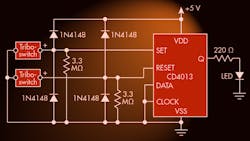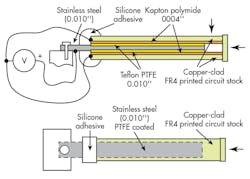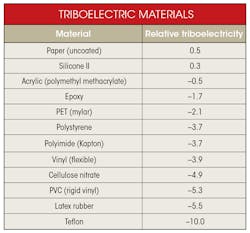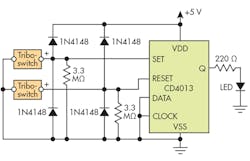This file type includes high-resolution graphics and schematics when applicable.
Triboelectricity, a form of electricity known for millennia, is the static electricity that pulls a spark from your finger to a switchplate on a winter day when the air is dry and the humidity is low. It's also the reason why most integrated circuits are stored in anti-static foams and bags.
It’s generated when certain combinations of materials are rubbed together. The quantity of electric charge that can be generated from rubbing depends on how well the materials can generate or accept electrons. The table ranks the triboelectricity of common materials. The ones which are widely separated in this table, such as acrylic and Teflon, will generate the most electrical charge when rubbed.
The triboelectric effect can be used in a simple switch (Fig. 1). A metal tine wrapped with Teflon tape is sandwiched between pieces of copper-clad epoxy circuit board stock and covered with Kapton tape (a polyimide film developed by DuPont in the late 1960s that remains stable across an extremely wide temperature range, from −270 to +400°C). The surfaces are in tight contact with each other, and are joined by a blob of silicone adhesive. In this case, Teflon and Kapton are used as the triboelectric couple, but other materials can be used.
The silicone adhesive allows a rubbing notion when the assembly is tapped from above or on end, as shown by the arrows. The generated charges are collected by the metal tine and the copper surfaces of the circuit board. When discharged into a large resistance, impressively high voltages can be generated (Fig. 2). (The author's demonstration switch was four inches long and ¾-inch wide, but smaller switches are possible.)
You can use such switches to activate CMOS digital circuitry (Fig. 3), where two triboelectric switches control a set-reset flip-flop and control an LED. The diodes prevent high voltages from damaging the input transistors of the CD4013 integrated circuit.
Looking for parts? Go to SourceESB.
About the Author
Dev Gualtieri
Dev Gualtieri received his PhD in solid-state science from Syracuse University in 1974. After many years doing research for a major aerospace company, he now does computer, electronic, and embedded-systems projects at his consulting company, Tikalon LLC (www.tikalon.com) in Ledgewood, N.J. He is the author of several books, available at Amazon.





